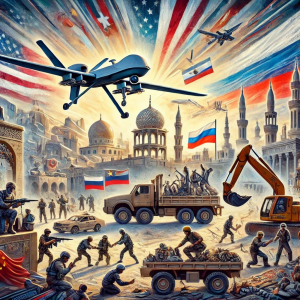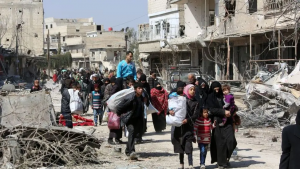What is Happening in Syria
A Closer Look at the Conflict, Global Reactions, and the Path Forward
Syria remains a hotspot for conflict and humanitarian concerns, as recent developments paint a grim picture of its ongoing crisis. This blog explores the latest updates, touching on the political, military, and humanitarian aspects in a conversational style to help you understand why the world is shocked by what is unfolding.
The Fall of Bashar al-Assad’s Stronghold
Let’s start with what everyone is talking about: the upheaval of Bashar al-Assad’s government. For over a decade, Assad held onto power, often with a tight grip. But recent months have turned the tide against his administration. Major cities like Hama, Homs, and Deir ez-Zor slipped out of government control, with rebel forces making significant gains.
In another dramatic turn of events, Bashar al-Assad and his family fled Syria and arrived in Russia in early December 2024, following the collapse of his regime. As rebel forces advanced and captured key territories, including Damascus, Assad reportedly negotiated his departure and handed over power. Russia, a longstanding ally, granted him asylum, marking the end of his family’s 54-year rule over Syria. The collapse was accompanied by widespread celebrations in Syria, with Syrians taking to the streets and looting government buildings.
The Shockwaves of the Conflict
If you’ve been following global reactions, you’ll know that the world is stunned by the recent escalation in Syria. Why? Because the scale and speed of the upheaval were unexpected. The international community had largely resigned itself to a long, drawn-out stalemate. But now, with Assad’s regime annihilated and the humanitarian crisis deepening, it’s clear that Syria’s future is more uncertain than ever.
What is the USA doing differently?
You might be wondering about the role of the United States in all this. Over the years, U.S. involvement in Syria has been a rollercoaster, from direct military interventions to a more hands-off approach. Recently, however, Washington has taken a different tack. Instead of boots on the ground, the U.S. has ramped up support for opposition groups through arms supplies and intelligence sharing. It’s a calculated move to tip the scales without getting directly entangled in the conflict.
But this strategy isn’t without controversy. Critics argue that arming opposition forces could lead to unintended consequences, such as weapons falling into extremist hands. On the flip side, proponents believe it was a necessary step to counter Assad and his allies.
Russia’s Deeper Involvement
Now, let’s talk about Russia. Moscow has been one of Assad’s staunchest supporters, providing military aid and conducting airstrikes to bolster his regime. But here’s the twist: recent reports suggested that even Russia was feeling the strain of the prolonged conflict. While it continued to back government forces and gave asylum to Assad, its increasing reliance on airstrikes has drawn international criticism for the high civilian toll.
Russia’s involvement isn’t just about Assad. It is about maintaining influence in the Middle East and countering Western dominance. By staying entrenched in Syria, Russia signals to the world that it’s a power player who won’t back down easily.

What does China Have to Gain?
China’s role in Syria might not be as visible as Russia’s, but it’s no less significant. Beijing has largely stayed out of the direct military conflict, focusing instead on economic and diplomatic avenues. Why? Because China sees post-war Syria as an opportunity for investment and a potential gateway to expand its Belt and Road Initiative.
At the same time, China’s position underscores its broader foreign policy: non-interference paired with strategic economic engagement. While Beijing officially calls for a political resolution, its actions suggest a long-term interest in leveraging Syria’s reconstruction for its own benefit.
The Saudi Perspective
Saudi Arabia’s stance on Syria has been complicated, to say the least. Historically, Riyadh has supported opposition forces in an effort to counter Iranian influence in the region. Recent developments, however, have prompted a more cautious approach. With Assad’s government losing ground, Saudi Arabia sees an opportunity to strengthen its regional clout while keeping a close eye on how events unfold.
There’s also a broader geopolitical angle. For Saudi Arabia, the Syrian conflict isn’t just about Assad—it’s part of a larger contest with Iran for dominance in the Middle East. The kingdom’s actions moving forward will likely be shaped by this ongoing rivalry.
The Gimmicks of Iran
Speaking of Iran, let’s not forget its pivotal role in Syria. Tehran has been one of Assad’s key allies, providing military support through the Islamic Revolutionary Guard Corps (IRGC) and proxy groups like Hezbollah. But the recent shifts on the ground have forced Iran to reevaluate its position. Reports suggest that Iranian forces are scaling back their presence in Syria, possibly to focus on domestic challenges and other regional priorities.
This doesn’t mean Iran is bowing out completely. On the contrary, it’s likely recalibrating its strategy to ensure it retains influence in a post-Assad Syria. How this plays out will be crucial for the balance of power in the Middle East.
The Humanitarian Toll
We’ve talked a lot about the politics and military aspects, but let’s not forget the human side of this tragedy. Millions of Syrians are caught in the crossfire, with many facing dire conditions in overcrowded camps or under siege in conflict zones. The international community has pledged aid, but access remains a major challenge due to ongoing hostilities.
Children, in particular, are bearing the brunt of the crisis. Many have been displaced multiple times, missing out on education and facing long-term psychological trauma. It’s a sobering reminder of the human cost of war, and a call to action for global leaders to prioritize humanitarian relief.

The Environmental Cost of Conflict
Here’s something that’s often overlooked: the environmental impact of war. Years of relentless bombings, destruction of infrastructure, and neglect have left Syria’s natural environment in ruins. Polluted rivers, deforested areas, and contaminated farmland are just a few of the issues that will take decades to address. Restoring the environment isn’t just about aesthetics—it’s critical for the health and livelihoods of the Syrian people.
Lessons for the International Community
The Syrian crisis has exposed the limitations of international diplomacy and the consequences of inaction. Delayed responses and fragmented strategies allowed the conflict to escalate to its current state. Moving forward, global powers need to develop more robust mechanisms for conflict prevention and resolution. Syria’s tragedy should serve as a wake-up call to the world.
Where Do We Go From Here?
So, what’s next for Syria? That’s the million-dollar question. The situation is fluid, with new developments emerging almost daily. While the immediate focus is on managing the humanitarian crisis, the long-term goal must be a sustainable political resolution.
This will require concerted efforts from all stakeholders, both local and international. Whether through peace talks, economic reconstruction, or grassroots reconciliation, the path forward will be complex and challenging. But one thing is clear: the world cannot afford to turn a blind eye to Syria’s plight.

